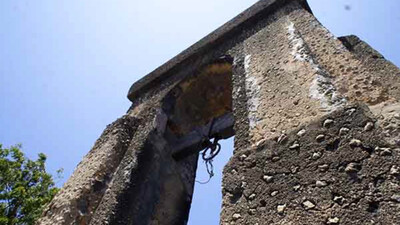
Mombasa
Kenya was once a popular tourist destination and a peaceful nation where different beliefs co-existed in harmony. You see this in Mombasa’s rich collection of Hindu temples, mosques, and churches of various denominations. These days, hardly a month goes by without news of exploding grenades, suspected homemade bombs and kidnap attempts. There is a real sense of insecurity wrought by indiscriminate terrorist acts. The day of my arrival was marked by rumors of homemade bombs in a Nairobi shopping mall. My driver seemed on edge and exercised a high degree of caution throughout my stay. On my last day I wanted to make a recording of the midday Adhan, but to be seen with recording equipment near a mosque would put both of us in danger of harassment. We found a parking spot opposite to the mosque. With the vehicle’s tinted windows rolled down, I placed the microphone on the backseat. The driver brought himself a plate of fruit from a nice boy across the street so he could pretend that he just parked to eat his lunch. The boy told us that the merciful call-for-prayers is due in 30 minutes. The rest of the meal passed in an extremely tense silence.
I came to Mombasa to track down a “slave trader warning bell,” but the current whereabouts of the bell and the circumstances surrounding its mysterious disappearance provide a glimpse into the nation’s troubled history. The coastal city was once a major hub of the East African slave trade. A bell tower stands in the district of Kengeleni. Its bell was once used as an alarm to warn townsfolk of the approach of the Arabic slave traders. I was informed by the National Museum of Kenya that the bell had long been stolen. The institution created a vanity fiberglass bell in its place, fenced off the area, and declared the bell tower a national monument. Upon arrival I discovered that the bell tower is now empty, even the fiberglass cast is gone. I was referred by the museum to Mr. Habel, the head priest at the St Emmanuel ACK Church, which is across the street from the Kengeleni Bell Tower. The vanity bell was cast out of the parish’s bell, and the church was built by and for the freed slaves. Mr. Habel in turn connected me to Mr. David Mwambila, a retired clergyman, who told me a wildly different version of the story. According to him, the slave-warning bell had not been stolen, but was moved into the St Emmanuel ACK Church for safekeeping, so that the bell that the church now uses for its service is in fact the original Kengeleni Bell. But this story doesn’t match up with the inscriptions on the church bell, which indicate that it was cast in 1895. The Kengeleni Bell Tower must certainly have predated that? The plot thickens: I visited New Freretown, where the freed slaves and their descendants have been resettled, and spoke with the village’s chief. Apparently in 2007 there was a dispute in the court in which the freed-slave descendants attempted to take ownership of the Emmanuel ACK Church. As the rows intensified the church’s Sunday service was briefly suspended. The New Freretown village chief told me that the community has since dropped the case. He was not forthcoming about the reasons for the decision, but confirmed Mr. Mwambila’s “relocation” story.
Exactly a month ago, the UK finally lifted its travel warning to the coastal regions of Kenya. The town is still pretty much deserted. Here, owners of minivan display texts and graphics to distinguish themselves from other operators. I spotted one that says: “tough times don’t last.” Another one reads: “thy grace is enough for me.”
To listen to the other recordings from this stop, please visit soundcloud.com/samsonyoung/sets/for-whom-the-bell-tolls-mombasa-kenya


